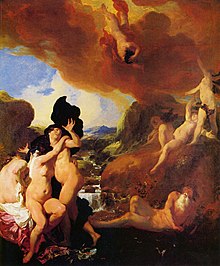Denis Mahon
Sir Denis Mahon | |
|---|---|
 Mahon in 1980 | |
| Born | John Denis Mahon 8 November 1910 London, England |
| Died | 24 April 2011 (aged 100)[1] 33 Cadogan Square, London, England[2] |
| Occupation(s) | Art collector and historian |

Sir John Denis Mahon,
Biography
Born in London into a wealthy Anglo-Irish family, his father John FitzGerald Mahon (fourth son of Sir William Vesey Ross Mahon,
A lover of opera, he decided not to enter the family business but study art, spending a year working at the Ashmolean Museum under the supervision of Kenneth Clark.[1] Clark then suggested him to his friend Nikolaus Pevsner, who had just joined the newly formed Courtauld Institute of Art in London. Pevsner introduced Mahon to Italian Mannerist and Baroque painting, and also gave him private tuition.[1]
Mahon bought his first artwork,
In 1936, Mahon began a long association with the National Gallery.[1] Serving as an honorary attache (informal, unpaid curator), he offered to buy Guercino's Elijah Fed By Ravens from the Barberini collection in Rome, and then sell it to the Gallery. However, Clark who was now the Gallery's Director, felt that it would be impossible to persuade the trustees of the merits of buying an Italian baroque painting.[1] As a result, Mahon decided to form his own collection, holding the pieces until such time as the national collections would be interested in them.[1] Mahon later twice served as a trustee of the National Gallery (1957–64; 1966–73), he was instrumental in pushing through important acquisitions, including Reni's Adoration of the Shepherds and with fellow trustee the sculptor Henry Moore Caravaggio's Salome Receives the Head of St John the Baptist.[1]
Mahon's Studies in Seicento Art and Theory, a series of essays promoting Italian art of the 17th century, was published in 1947. In the 1960s, Mahon and Sir Anthony Blunt became embroiled in a public feud over the iconography of the paintings of Nicolas Poussin, a subject in which both had published extensively and were recognised experts.[5]
In the 1970s he came into disagreement with
In the 1990s, Mahon donated his entire 57 piece art collection to various museums in the UK, the
Mahon authenticated two versions of Caravaggio's The Taking of Christ as original: one in the National Gallery of Ireland in 1993, and the other in Florence in 2004. Jonathan Harr disputes the later attribution, ascribing it to Mahon's advanced age.[7][8]
Mahon lived at 33 Cadogan Square, London. He died on 24 April 2011, aged 100.[2]
Awards
Mahon was appointed a
In 1957 Mahon was awarded the Medal for Benemeriti della Cultura by the Italian president, for services to criticism and history of Italian art.[9] In 1982 he was made an honorary citizen of Cento, Guercino's birthplace.[4]
Made a fellow of the British Academy in 1964, it awarded him its Serena Medal for Italian Studies in 1972. In 1996 he was made an honorary student of Christ Church, Oxford.[4]
Legacy
In the 1990s, Mahon lent his entire 57 piece art collection to various museums in the UK, the
In a complex legal arrangement via his personal charitable trust, a number of these paintings (such as
In 2010, Mahon donated his entire library and archive to the National Gallery of Ireland.[12]
After his death, the trustees of the charitable trust under instruction from Mahon's Will offered to donate the pieces to the national collection for free via The Art Fund, subject to the same conditions under which they were originally loaned. If these conditions were broken, then the arts owner The Art Fund could ask for their immediate return.[10] He also left the Art Fund a further £1 million cash bequest.[9][10]
References
- ^ a b c d e f g h i j k l Finaldi, Gabriele (28 April 2011). "Sir Denis Mahon obituary". guardian. London. Retrieved 28 April 2011.
- ^ a b c d "Sir Denis Mahon". The Independent. 12 May 2011. Retrieved 20 February 2013.
- ^ a b c "Denis Mahon". Dictionary of Art Historians. Archived from the original on 3 June 2008. Retrieved 22 May 2010.
- ^ a b c d e "Sir Denis Mahon – Obituary". The Telegraph. 28 April 2011. Retrieved 20 February 2013.
- ^ Anthony Blunt: His Lives, by Miranda Carter, 2001.
- ^ "Guercino's "King David" and "The Cumaean Sibyl with Putto" Displayed Together at the National Gallery". ArtDaily. 9 November 2010. Retrieved 15 November 2010.
- ISBN 0-375-50801-5.
- ^ Daley, Michael (30 September 2014). "Art's Toxic Assets and a Crisis of Connoisseurship Artwatch". ArtWatch UK. Retrieved 30 November 2016.
- ^ a b c "Sir Denis Mahon's £100m art collection left to nation". BBC News. 20 February 2013. Retrieved 20 February 2013.
- ^ a b c Charlotte Higgins (19 February 2013). "Old master paintings worth £100m given to Britain – with strings attached". Guardian.co.uk. Retrieved 20 February 2013.
- ^ Appleyard, Brian (23 February 2003). "The artful codger: Sir Denis Mahon". The Times. London. Retrieved 22 May 2010.
- ^ "Library and Archive of Sir Denis Mahon". National Gallery of Ireland. Archived from the original on 1 July 2014. Retrieved 20 February 2013.
Further reading
- Finaldi, Gabriele (1997). OCLC 1301980190 – via the Internet Archive.
